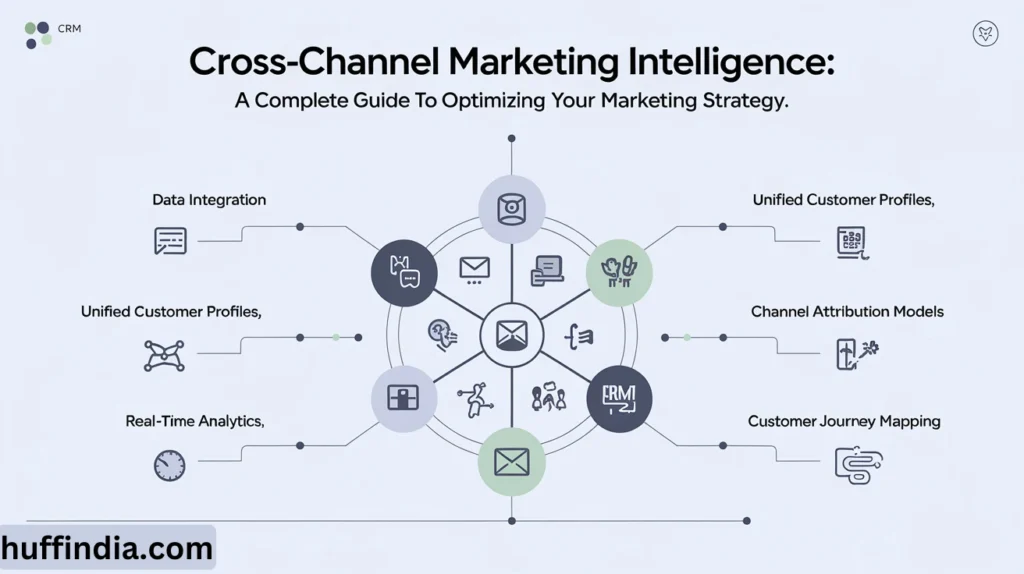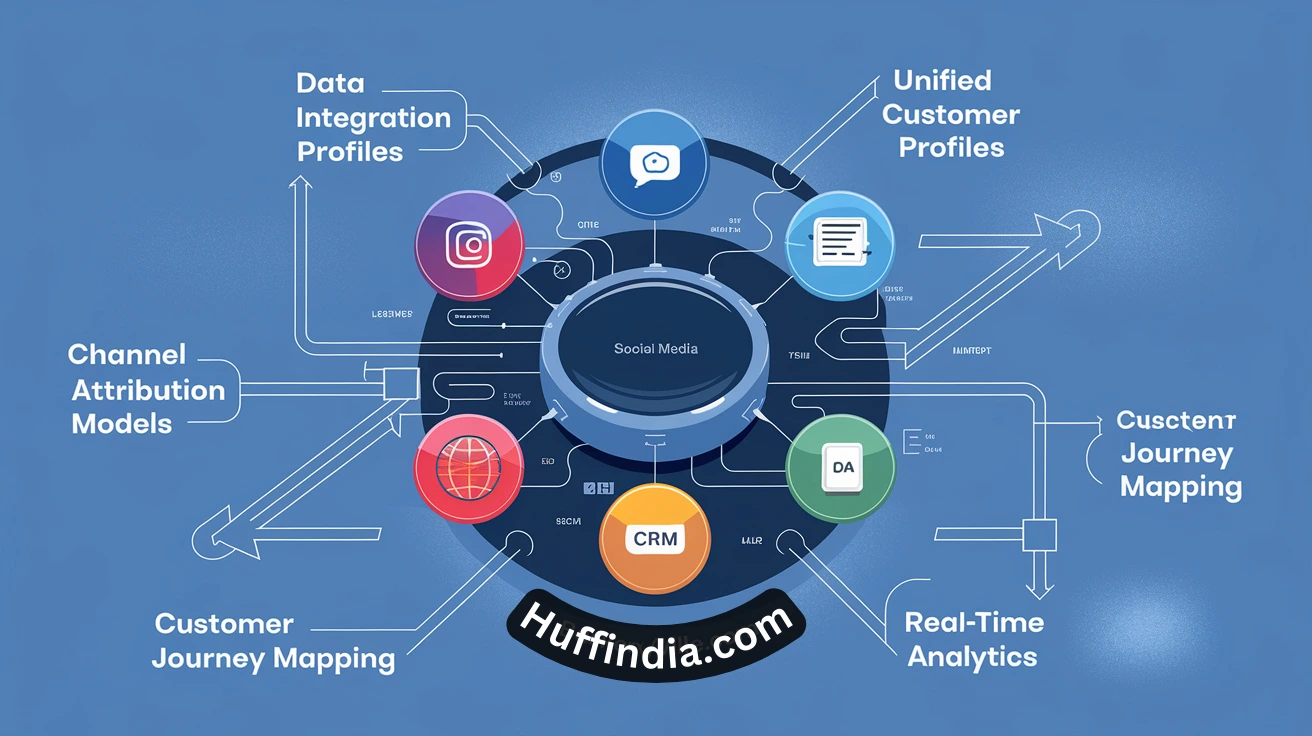As digital marketing evolves, brands today have a wealth of channels for connecting with their audience. From social media and email to display ads and search engines, these touchpoints are vital to reaching and engaging consumers. Each channel, however, functions differently, and many customers interact with a brand across multiple channels before making a purchase decision. This complex dynamic makes cross-channel marketing intelligence essential. By gathering insights across platforms, brands can create cohesive, data-driven strategies that deliver consistent experiences and boost ROI.
This article delves into the fundamentals of cross-channel marketing intelligence, its key benefits, and actionable steps to leverage it for business growth.

1. What is Cross-Channel Marketing Intelligence?
Cross-channel marketing intelligence involves analyzing data from multiple marketing channels to gain a comprehensive view of consumer behavior and optimize campaigns. Instead of isolating insights by channel, cross-channel intelligence integrates data from sources such as social media, websites, mobile apps, and email. As a result, this approach provides a unified perspective on the audience’s journey.
When brands break down these data silos, they gain a holistic understanding of how each channel influences the overall customer experience. Additionally, it enables companies to align messaging and strategies across all channels, ensuring that customers receive consistent and relevant communication.
2. Why Cross-Channel Marketing Intelligence Matters
Implementing cross-channel marketing intelligence brings multiple benefits, especially for brands aiming to maximize marketing effectiveness. Here are some key advantages:
a) Holistic Customer View
- With cross-channel intelligence, brands can better understand how customers interact across different platforms. Consequently, this leads to more precise segmentation and improved targeting.
b) Increased ROI
- By identifying which channels work best at different stages of the customer journey, marketers can allocate resources more effectively. As a result, they achieve a higher ROI across all platforms.
c) Enhanced Personalization
- With integrated data, brands can deliver more personalized experiences based on customer preferences and behaviors. This approach not only boosts conversion rates but also strengthens customer loyalty.
d) Detailed Customer Journey Mapping
- Cross-channel insights provide an in-depth view of the entire customer journey, from initial awareness to purchase. Therefore, brands can optimize each touchpoint to enhance customer satisfaction.
3. Key Components of Cross-Channel Marketing Intelligence
To build an effective cross-channel marketing intelligence strategy, several core components are essential. Here’s a closer look at each:
a) Data Integration
- First, integrating data from diverse sources such as CRM, social media, website analytics, and email is crucial. Through data integration, brands establish a comprehensive dataset for analysis.
b) Unified Customer Profiles
- Consolidated data allows brands to create unified profiles for each customer. As a result, marketers can understand individual preferences, behaviors, and journey stages more accurately.
c) Channel Attribution Models
- Attribution models assign value to each channel’s role in conversions. With proper attribution, brands understand the impact of each platform, allowing them to allocate resources wisely.
d) Real-Time Analytics and Reporting
- Many cross-channel marketing intelligence platforms provide real-time insights. Consequently, marketers can respond immediately to changes in customer behavior, optimizing campaigns on the go.
4. Steps to Implement Cross-Channel Marketing Intelligence
Implementing an effective cross-channel marketing intelligence strategy requires several key steps. Here’s a breakdown:
Step 1: Define Goals and KPIs
- To begin, set clear goals and KPIs that align with your business objectives. Decide if your main goal is to increase conversions, improve engagement, or enhance the customer journey.
Step 2: Choose the Right Technology Stack
- Choosing the right tools is essential for gathering and analyzing cross-channel data. Platforms like Google Analytics, HubSpot, and Adobe Experience Cloud are popular choices that support data integration.
Step 3: Integrate Data Across Channels
- Next, ensure data is collected from all relevant platforms. Fortunately, API integrations, data management platforms (DMPs), and customer data platforms (CDPs) can streamline this process.
Step 4: Build Unified Customer Profiles
- By consolidating data into unified profiles, brands gain valuable insights into individual customer journeys. This also helps segment audiences based on specific behaviors or demographics.
Step 5: Analyze and Attribute
- After gathering data, utilize attribution models to assess the impact of each channel on conversions. Testing different models can help you identify which approach yields the best results.
Step 6: Optimize Based on Insights
- With insights in hand, adjust your strategy to improve performance. For example, if social media drives awareness while email boosts conversions, reallocate resources accordingly.
5. Best Practices for Cross-Channel Marketing Intelligence
To maximize the benefits of cross-channel intelligence, adhering to best practices is essential. Consider the following:
a) Maintain Data Quality
- Ensuring data consistency and accuracy is vital. Therefore, regularly clean and organize your data to maintain its reliability.
b) Prioritize Privacy and Compliance
- Privacy regulations like GDPR and CCPA require that brands handle data responsibly. To remain compliant, use anonymization and encryption as needed.
c) Adopt a Customer-Centric Approach
- Focusing on the customer experience is key. As a result, brands should use cross-channel insights to create relevant messaging and provide consistent interactions across channels.
d) Test and Iterate Continuously
- Cross-channel intelligence is an evolving process. Thus, marketers should regularly test strategies, analyze results, and refine their approaches to stay effective.
e) Encourage Team Collaboration
- Because cross-channel intelligence affects the customer journey, collaboration between marketing, sales, and customer service is crucial. When teams work together, alignment and consistency improve.
6. Challenges in Cross-Channel Marketing Intelligence
While cross-channel marketing intelligence offers significant benefits, brands may encounter a few challenges:
a) Data Silos
- Integrating data from multiple sources can be difficult, especially in larger organizations. Consequently, brands may struggle to achieve a unified view of their audience.
b) Attribution Complexity
- Attribution often requires sophisticated models, particularly in multi-touch environments. Therefore, properly attributing conversions can be challenging.
c) Privacy Regulations
- Complying with privacy laws while managing cross-channel data is complex. Thus, balancing regulatory requirements with data needs can be demanding.
d) Resource Requirements
- Implementing cross-channel intelligence often requires substantial investments in technology and personnel. For this reason, it can be resource-intensive, especially for smaller brands.
7. Future of Cross-Channel Marketing Intelligence
As technology advances, cross-channel marketing intelligence is expected to grow even more powerful. For instance, AI and machine learning will enable deeper analysis, allowing brands to deliver highly personalized experiences. Additionally, the integration of online and offline channels will make cross-channel insights even more valuable. Brands that invest in cross-channel intelligence now will likely gain a competitive advantage, creating cohesive customer journeys and fostering stronger loyalty.
Conclusion
In summary, cross-channel marketing intelligence is an invaluable tool for brands aiming to deliver seamless, personalized customer experiences. By integrating and analyzing data from multiple platforms, marketers can optimize campaigns, effectively engage customers, and improve ROI. With the right tools, strategy, and commitment to data quality, cross-channel intelligence can transform marketing efforts, helping brands connect with their audience and enhance every touchpoint.


























